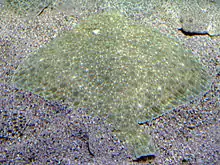鰈
| ||||||||
Translingual
Han character
鰈 (Kangxi radical 195, 魚+9, 20 strokes, cangjie input 弓火心廿木 (NFPTD), four-corner 24394, composition ⿰魚枼)
References
- KangXi: page 1474, character 24
- Dai Kanwa Jiten: character 46322
- Dae Jaweon: page 2006, character 16
- Hanyu Da Zidian (first edition): volume 7, page 4700, character 2
- Unihan data for U+9C08
Chinese
| trad. | 鰈 | |
|---|---|---|
| simp. | 鲽 | |
Glyph origin
| Old Chinese | |
|---|---|
| 貰 | *ɦljebs, *hljebs |
| 跇 | *l̥ʰebs, *lebs |
| 迣 | *ʔljebs |
| 世 | *hljebs |
| 泄 | *lebs, *sled |
| 枻 | *lebs |
| 詍 | *lebs |
| 靾 | *lebs |
| 袣 | *lebs |
| 抴 | *lebs, *led |
| 呭 | *lebs |
| 勩 | *lebs, *libs |
| 屜 | *l̥ʰeːbs |
| 鰈 | *l̥ʰaːb, *l'eːb |
| 渫 | *zreːb, *sled |
| 煠 | *zreːb, *l̥ʰeb, *leb |
| 喋 | *rlaːb, *ʔl'eːb, *l'eːb |
| 鞢 | *rlaːb, *sleːb |
| 殜 | *l'eb, *leb, *lab |
| 葉 | *hljeb, *leb |
| 弽 | *hljeb, *hleːb |
| 韘 | *hljeb, *sleːb |
| 枼 | *leb |
| 楪 | *leb |
| 揲 | *leb, *l'eːb, *ɦljed |
| 鍱 | *leb |
| 偞 | *leb, *hleːb |
| 蝶 | *l̥ʰeːb, *l'eːb |
| 牒 | *l'eːb |
| 蹀 | *l'eːb |
| 諜 | *l'eːb |
| 堞 | *l'eːb |
| 牃 | *l'eːb |
| 褋 | *l'eːb |
| 惵 | *l'eːb |
| 碟 | *l'eːb |
| 屧 | *sleːb |
| 屟 | *sleːb |
| 紲 | *sled |
| 齛 | *sled |
| 疶 | *sled |
| 緤 | *sled |
| 媟 | *sled |
魚 (“fish”) + 枼 (“table, flat wood”) – flat (枼) fish (魚).
Pronunciation
Definitions
鰈
- righteye flounder
Compounds
|
|
|
Japanese
Kanji
(uncommon “Hyōgai” kanji)
- sole
- flatfish
- flounder
Readings
- Go-on: じょう (jō)←でふ (defu, historical); とう (tō)←たふ (tafu, historical)
- Kan-on: ちょう (chō)←てふ (tefu, historical); とう (tō)←たふ (tafu, historical)
- Kun: かれい (karei, 鰈)←かれひ (karefi, historical)
Compounds
- 鰈崎 (Kareizaki), 鰈崎 (Karezaki)
- 鰈川 (Karegawa)
Etymology

| Kanji in this term |
|---|
| 鰈 |
| かれい Hyōgaiji |
| kun’yomi |
/kara epi1/ → /karepi/ → /karefi/ → */karewi/ → */kareii/ → /karei/
Likely from Old Japanese. Attested in the Honzō Wamyō. The Wamyō Ruijushō has 王餘魚, with the phonetic spellings 加良衣比 (karaepi1) and variant 加禮比 (karepi1).
Originally a compound of 韓 (Kara, “Korea”, euphemism) + 鱝 (ei, “a kind of ray”). It is said that the flounder was imported from Korea to Japan in the Samhan period, and was regarded to the Koreans at that time as "beautiful". The ei part is likely due to its appearance, mistaken for a "ray". (Can this(+) etymology be sourced?)
Pronunciation
- Kun’yomi
- (Tokyo) かれー [káꜜrèè] (Atamadaka – [1])[1]
- IPA(key): [ka̠ɾe̞ː]
Noun
鰈 • (karei) ←かれひ (karefi)?
- righteye flounder (flounder of the family Pleuronectidae)
Usage notes
- As with many terms that name organisms, this term is often spelled in katakana, especially in biological contexts (where katakana is customary), as カレイ.
Derived terms
- カレイ科 (karei-ka, “Pleuronectidae”)
- カレイ目 (karei-moku, “Pleuronectiformes”)
- 赤鰈 (aka-garei, “flathead flounder”)
- 油鰈 (abura-garei, “Kamchatka flounder”)
- 石鰈 (ishi-garei, “stone flounder”)
- 角鰈 (tsuno-garei, “Alaska plaice”)
- 滑多鰈 (nameta-garei), 婆婆鰈 (baba-garei, “slime flounder”)
- 沼鰈 (numa-garei, “starry flounder”)
- 真鰈 (ma-garei, “yellow striped flounder”)
- 真子鰈 (mako-garei, “marbled flounder”)
Idioms
- 左鮃右鰈 (hidari hirame migi karei)
See also
- 牛舌魚, 牛の舌 (ushi-no-shita, “sole”)
- 平目, 鮃 (hirame, “olive flounder, Japanese halibut”)
References
- 2006, 大辞林 (Daijirin), Third Edition (in Japanese), Tōkyō: Sanseidō, →ISBN
Korean
Hanja
鰈 • (jeop) (hangeul 접, revised jeop, McCune–Reischauer chŏp, Yale cep)
- This term needs a translation to English. Please help out and add a translation, then remove the text
{{rfdef}}.